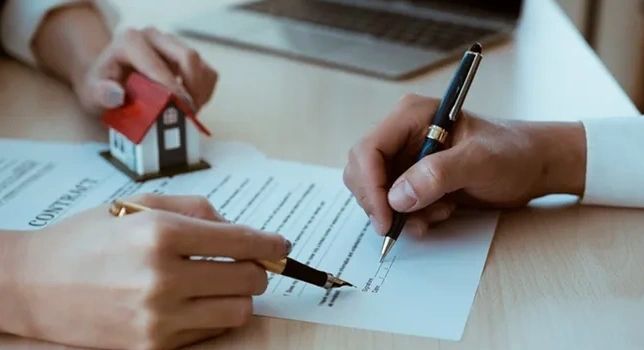BuySellBA
Administrator
Rentals in Buenos Aires: Supply has increased by 176% and prices have dropped by 34% - Ambito Financiero

Source:

 www.ambito.com
www.ambito.com
June 06, 2025
By Liliana Franco
The impact of the stamp tax in Buenos Aires and the prospect of "cushion dollars" are some of the topics discussed with Marta Liotto , representative of the Real Estate Association of the City of Buenos Aires.

Of the housing offerings in Buenos Aires, 96% are apartments and the rest are houses and townhouses.
In the last year and a half, the supply of rental properties in the City of Buenos Aires increased by 176%, and real rental prices fell by 34%. This was stated by Marta Liotto of the Real Estate Association in an interview with Ámbito .
Home purchases using mortgage loans are on the rise. The average purchase price per square meter in the capital is around US$2,300, depending on the neighborhood.
The impact of the stamp tax in Buenos Aires and the prospect of "cushion dollars" are some of the topics discussed with the sector representative.

Marta Liotto , from the Real Estate Association of the City of Buenos Aires.
Journalist: How is the real estate sector doing in terms of rentals?
Marta Liotto: Over the last year and a half, the supply of rental properties in the City of Buenos Aires has increased by 176%, with a 10.87% increase in the last month. With these figures, we are looking at a market in which the volume of supply adequately meets all the demand.
We can add that, of the housing supply, 96% is apartments, and the remainder is houses and townhouses. Six neighborhoods account for 56% of the rental housing supply, and the neighborhood with the most supply is Palermo, which accounts for more than 21% of the city's total.
Regarding rental prices, from January 2024 to March 2025, there was a 34% drop in real rental prices. This means that, although there have been logical nominal increases, rents appreciated less than the rest of the economy's goods and services.
Counteroffers from tenants are already being observed, most of which are accepted by the owners. And rental terms are for 24 months, generally in pesos, and are adjusted quarterly according to the CPI. This applies to both residential and office spaces.
Regarding commercial rentals, the truth is that supply remains stable. In the City of Buenos Aires, we have 1,865 listed commercial spaces today, representing about a quarter of the total available. This is 2.5% less than the previous month, which means that more commercial spaces were rented. This reflects the economic recovery in the country and in the City.
Regarding office space, 5,245 are listed, which is 1% less than the previous month. This means that supply continues to be absorbed. Of the total office space available, 53% is for rent and the remainder is for sale.
Q: How much does a 2- and 3-room rental cost on average (the cheapest and most expensive)?
ML: The Federal Capital is very large. In its 48 public neighborhoods and 15 communes, there are units for all tastes. There's a lot of supply in any neighborhood, and this affects the price range.
For example, a two-room apartment, a low average price is around $300,000, always in quieter neighborhoods of Buenos Aires City, such as Flores, San Cristóbal, etc. And the highest prices in Buenos Aires City could be, for two-room apartments, between $5,000 and $6,000, most of which are in Puerto Madero, Belgrano, among other neighborhoods.
The highest-priced three-bedroom apartments for rent are around $7,500 to $8,000, mostly in Puerto Madero. The cheapest three-bedroom apartments are in Congreso, San Nicolás, and Villa Lugano, and can be found between $450,000 and $500,000.
Q: And the locals?
ML: Regarding commercial rentals, the truth is that supply remains stable. In the City of Buenos Aires, we have 1,865 listed commercial spaces today, representing about a quarter of the total available space. This is 2.5% less than the previous month, which means that more commercial spaces were rented. This reflects the economic recovery in the country and in the City.
Regarding office space, 5,245 are listed, which is 1% less than the previous month. This means that supply continues to be absorbed. Of the total office space available, 53% is for rent, and the remainder is for sale .
Commercial rents, the cheapest (they average approximately 1 million pesos) in areas such as Parque Patricios or some in the Center.
The reality is that the retail market is highly dispersed, and the value always depends on whether it's located in an open-air shopping center or not, among many other factors, such as the surface area, the characteristics of each space, etc.
Among the most expensive (which can range from $5,000 to $8,000 or even $10,000, depending on the area) are Cabildo and Santa Fe avenues, and some other areas of Palermo.
Q: What are the most in-demand areas?
ML: The most sought-after areas, both for rent and for sale, are those with the best infrastructure, green spaces, security, shopping centers, etc. These are always Palermo, Belgrano, Barrio Norte, Recoleta, Caballito, and Puerto Madero.
ML: The average price per square meter in the City of Buenos Aires is approximately US$2,350. It's important to keep in mind that there are 48 public neighborhoods, with subway tickets priced at US$1,000 in some neighborhoods and US$6,000 in others. Therefore, each neighborhood has a different volume of demand and supply, different infrastructure, and therefore different closing prices per square meter. There are many types of apartments, and the value depends on many factors, but the average price could be estimated at US$2,350.
Q: Is it a good idea to buy a property today? Why?
ML: It's a good idea to buy a property today because you'll be able to acquire more square meters than tomorrow. The value per square meter remains cheap and has potential for growth in the coming months, especially with the replacement value, given the high cost of construction. This indicates that, along with other variables such as mortgage loans and banking, they're driving demand.
Q: Is it true that prices are rising, why?
ML: Prices are rising, but very slowly. And it's a price that's lagging behind in the economy, one of the least likely to rise compared to other goods and services in the economy. It's driven by mortgage lending and money laundering. It was restricted in recent years due to the lack of access to currency exchange and the inability to save, but now it is. In fact, last year, wages in dollars increased by 100%, which all generates increased demand and higher prices. Furthermore, the value per square meter of construction, which is the so-called replacement value, is extremely high.
Q: How many mortgage loan transactions are carried out?
ML: In the City of Buenos Aires, we average a thousand mortgage loan transactions per month , which has an impact on the volume sold. The most common transactions using this type of tool are those up to US$120,000.
Q: Do you think there will be a mortgage loan boom?
ML: If macroeconomic conditions persist—a stable exchange rate, downward inflation, and a recovery in real wages (the average dollar wage)—we can expect the use of these tools to continue to grow.
For this to happen, the important thing is that banks maintain their conditions. This is important to emphasize because many banks have recently raised their interest rates due to the scarcity of pesos in the market. This hinders the proliferation of mortgage loans.
The reality is that we expect home loans to continue to increase, surpassing the 1,500-loan barrier per month in the next three to four months, provided macroeconomic conditions, which allow access to loans, remain unchanged.
Q: What procedures or requirements should be eliminated to facilitate and lower the costs of real estate transactions?
ML: This is an extremely complex question since access to operations requires professional services that guarantee these, and, in general, most costs are not that influential.
Q: Are there any taxes that make buying and selling more expensive?
ML: The expense with the greatest impact is the Stamp Tax. Specifically, in the City of Buenos Aires, the rate is extremely high and significantly impacts costs. This is a tax that the City should eliminate because, in cases where the buyer already owns a property registered in Buenos Aires, it has a significant impact on the final price.
ML: Real estate agents are information agents for the UIF and must strictly apply the regulations, ensuring that there is a relationship between the transaction and the financial situation of the parties involved.
There are several reporting procedures and systems to complete each month, and several reports to prepare. But, in short, the real estate operator must know the parties involved in the transaction.
Q: The government announced a series of measures to allow the use of undeclared funds. What would need to be repealed to allow them to be used in a real estate transaction?
ML: Regarding the measures announced by the government to be able to use undeclared funds, everything related to tax issues must be modified, so that we can't go back and try to charge people for undeclared income, such as profits or VAT, because those would be huge amounts.
It's important to note that there are many issues (many of them laws that must be passed by Congress) that will need to be changed to give people security and allow them to use their money with peace of mind.
Just to give an example, in last year's money laundering (which was very effective), it was stipulated that those who adhered to the regime would not be able to externalize funds again until 2038. What happens to these people if they have any outstanding balances left to launder? It seems like a minor detail, but these are issues that will need to be addressed for the measures to be effective.
Q: Are you seeing more supply of well works?
ML: We perceive a stable supply, with neither a significant increase nor a sharp decline. We must be very cautious when launching a development for pre-sale because while the construction cost may be high in today's scenario, a development takes 24 or 36 months; it's a film, and the prorated cost over those two or three years will be lower than what we see today.
Q: How would you assess the real estate sector?
ML: Real estate activity is quite good today. The market is looking green, so it's dynamic and growing. If this trend continues (and we real estate agents believe it will), the situation will continue to rise, both in sales and rentals, and in the use of mortgage loans.
www.buysellba.com

Source:

Alquileres en CABA: advierten que la oferta aumentó 176% y los precios bajaron 34%
El peso del impuesto a los sellos en CABA y la expectativa de los “dólares colchón”, son algunos de los temas conversados con Marta Liotto, representante del Colegio Inmobiliario de la Ciudad de Buenos Aires.
June 06, 2025
By Liliana Franco
The impact of the stamp tax in Buenos Aires and the prospect of "cushion dollars" are some of the topics discussed with Marta Liotto , representative of the Real Estate Association of the City of Buenos Aires.

Of the housing offerings in Buenos Aires, 96% are apartments and the rest are houses and townhouses.
In the last year and a half, the supply of rental properties in the City of Buenos Aires increased by 176%, and real rental prices fell by 34%. This was stated by Marta Liotto of the Real Estate Association in an interview with Ámbito .
Home purchases using mortgage loans are on the rise. The average purchase price per square meter in the capital is around US$2,300, depending on the neighborhood.
The impact of the stamp tax in Buenos Aires and the prospect of "cushion dollars" are some of the topics discussed with the sector representative.

Marta Liotto , from the Real Estate Association of the City of Buenos Aires.
Journalist: How is the real estate sector doing in terms of rentals?
Marta Liotto: Over the last year and a half, the supply of rental properties in the City of Buenos Aires has increased by 176%, with a 10.87% increase in the last month. With these figures, we are looking at a market in which the volume of supply adequately meets all the demand.
We can add that, of the housing supply, 96% is apartments, and the remainder is houses and townhouses. Six neighborhoods account for 56% of the rental housing supply, and the neighborhood with the most supply is Palermo, which accounts for more than 21% of the city's total.
Regarding rental prices, from January 2024 to March 2025, there was a 34% drop in real rental prices. This means that, although there have been logical nominal increases, rents appreciated less than the rest of the economy's goods and services.
Counteroffers from tenants are already being observed, most of which are accepted by the owners. And rental terms are for 24 months, generally in pesos, and are adjusted quarterly according to the CPI. This applies to both residential and office spaces.
Regarding commercial rentals, the truth is that supply remains stable. In the City of Buenos Aires, we have 1,865 listed commercial spaces today, representing about a quarter of the total available. This is 2.5% less than the previous month, which means that more commercial spaces were rented. This reflects the economic recovery in the country and in the City.
Regarding office space, 5,245 are listed, which is 1% less than the previous month. This means that supply continues to be absorbed. Of the total office space available, 53% is for rent and the remainder is for sale.
Q: How much does a 2- and 3-room rental cost on average (the cheapest and most expensive)?
ML: The Federal Capital is very large. In its 48 public neighborhoods and 15 communes, there are units for all tastes. There's a lot of supply in any neighborhood, and this affects the price range.
For example, a two-room apartment, a low average price is around $300,000, always in quieter neighborhoods of Buenos Aires City, such as Flores, San Cristóbal, etc. And the highest prices in Buenos Aires City could be, for two-room apartments, between $5,000 and $6,000, most of which are in Puerto Madero, Belgrano, among other neighborhoods.
The highest-priced three-bedroom apartments for rent are around $7,500 to $8,000, mostly in Puerto Madero. The cheapest three-bedroom apartments are in Congreso, San Nicolás, and Villa Lugano, and can be found between $450,000 and $500,000.
Q: And the locals?
ML: Regarding commercial rentals, the truth is that supply remains stable. In the City of Buenos Aires, we have 1,865 listed commercial spaces today, representing about a quarter of the total available space. This is 2.5% less than the previous month, which means that more commercial spaces were rented. This reflects the economic recovery in the country and in the City.
Regarding office space, 5,245 are listed, which is 1% less than the previous month. This means that supply continues to be absorbed. Of the total office space available, 53% is for rent, and the remainder is for sale .
Commercial rents, the cheapest (they average approximately 1 million pesos) in areas such as Parque Patricios or some in the Center.
The reality is that the retail market is highly dispersed, and the value always depends on whether it's located in an open-air shopping center or not, among many other factors, such as the surface area, the characteristics of each space, etc.
Among the most expensive (which can range from $5,000 to $8,000 or even $10,000, depending on the area) are Cabildo and Santa Fe avenues, and some other areas of Palermo.
Q: What are the most in-demand areas?
ML: The most sought-after areas, both for rent and for sale, are those with the best infrastructure, green spaces, security, shopping centers, etc. These are always Palermo, Belgrano, Barrio Norte, Recoleta, Caballito, and Puerto Madero.
Purchase and sale of real estate
Q: What is the average price per square meter for property purchases?ML: The average price per square meter in the City of Buenos Aires is approximately US$2,350. It's important to keep in mind that there are 48 public neighborhoods, with subway tickets priced at US$1,000 in some neighborhoods and US$6,000 in others. Therefore, each neighborhood has a different volume of demand and supply, different infrastructure, and therefore different closing prices per square meter. There are many types of apartments, and the value depends on many factors, but the average price could be estimated at US$2,350.
Q: Is it a good idea to buy a property today? Why?
ML: It's a good idea to buy a property today because you'll be able to acquire more square meters than tomorrow. The value per square meter remains cheap and has potential for growth in the coming months, especially with the replacement value, given the high cost of construction. This indicates that, along with other variables such as mortgage loans and banking, they're driving demand.
Q: Is it true that prices are rising, why?
ML: Prices are rising, but very slowly. And it's a price that's lagging behind in the economy, one of the least likely to rise compared to other goods and services in the economy. It's driven by mortgage lending and money laundering. It was restricted in recent years due to the lack of access to currency exchange and the inability to save, but now it is. In fact, last year, wages in dollars increased by 100%, which all generates increased demand and higher prices. Furthermore, the value per square meter of construction, which is the so-called replacement value, is extremely high.
Q: How many mortgage loan transactions are carried out?
ML: In the City of Buenos Aires, we average a thousand mortgage loan transactions per month , which has an impact on the volume sold. The most common transactions using this type of tool are those up to US$120,000.
Q: Do you think there will be a mortgage loan boom?
ML: If macroeconomic conditions persist—a stable exchange rate, downward inflation, and a recovery in real wages (the average dollar wage)—we can expect the use of these tools to continue to grow.
For this to happen, the important thing is that banks maintain their conditions. This is important to emphasize because many banks have recently raised their interest rates due to the scarcity of pesos in the market. This hinders the proliferation of mortgage loans.
The reality is that we expect home loans to continue to increase, surpassing the 1,500-loan barrier per month in the next three to four months, provided macroeconomic conditions, which allow access to loans, remain unchanged.
Q: What procedures or requirements should be eliminated to facilitate and lower the costs of real estate transactions?
ML: This is an extremely complex question since access to operations requires professional services that guarantee these, and, in general, most costs are not that influential.
Q: Are there any taxes that make buying and selling more expensive?
ML: The expense with the greatest impact is the Stamp Tax. Specifically, in the City of Buenos Aires, the rate is extremely high and significantly impacts costs. This is a tax that the City should eliminate because, in cases where the buyer already owns a property registered in Buenos Aires, it has a significant impact on the final price.
What is expected to happen with the mattress dollars?
Q: What requirements do real estate agencies have for controlling the source of funds when purchasing or renting a property?ML: Real estate agents are information agents for the UIF and must strictly apply the regulations, ensuring that there is a relationship between the transaction and the financial situation of the parties involved.
There are several reporting procedures and systems to complete each month, and several reports to prepare. But, in short, the real estate operator must know the parties involved in the transaction.
Q: The government announced a series of measures to allow the use of undeclared funds. What would need to be repealed to allow them to be used in a real estate transaction?
ML: Regarding the measures announced by the government to be able to use undeclared funds, everything related to tax issues must be modified, so that we can't go back and try to charge people for undeclared income, such as profits or VAT, because those would be huge amounts.
It's important to note that there are many issues (many of them laws that must be passed by Congress) that will need to be changed to give people security and allow them to use their money with peace of mind.
Just to give an example, in last year's money laundering (which was very effective), it was stipulated that those who adhered to the regime would not be able to externalize funds again until 2038. What happens to these people if they have any outstanding balances left to launder? It seems like a minor detail, but these are issues that will need to be addressed for the measures to be effective.
Q: Are you seeing more supply of well works?
ML: We perceive a stable supply, with neither a significant increase nor a sharp decline. We must be very cautious when launching a development for pre-sale because while the construction cost may be high in today's scenario, a development takes 24 or 36 months; it's a film, and the prorated cost over those two or three years will be lower than what we see today.
Q: How would you assess the real estate sector?
ML: Real estate activity is quite good today. The market is looking green, so it's dynamic and growing. If this trend continues (and we real estate agents believe it will), the situation will continue to rise, both in sales and rentals, and in the use of mortgage loans.
www.buysellba.com

